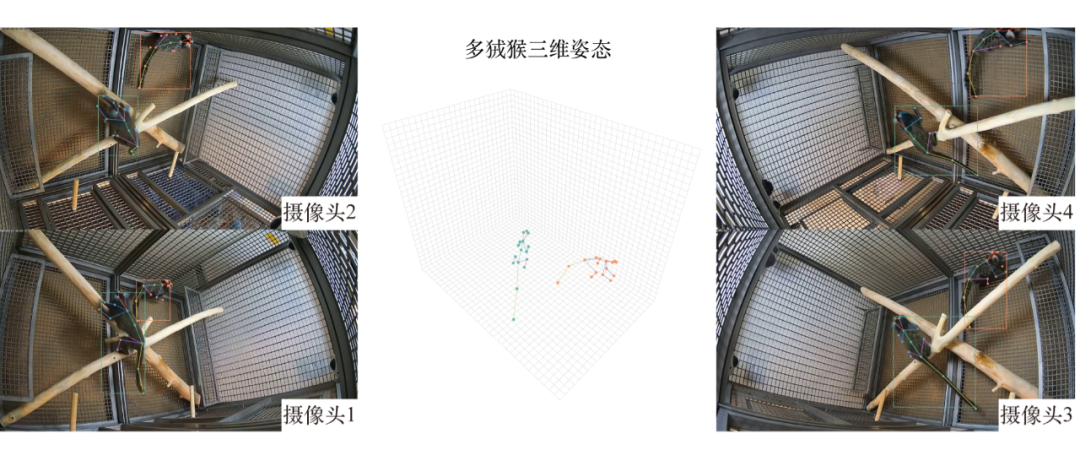Professor Xiaoqin Wang's team at Tsinghua University Brain and Intelligence Laboratory (THBI) recently published a multi-marmoset 3D pose real-time tracking system named "MarmoPose" in the journal Cell Reports Methods. This system was jointly developed by Chaoqun Cheng, a doctoral student at Tsinghua University School of Biomedical Engineering, and other laboratory members. It can accurately track the 3D poses of multiple marmosets in real-time during free activity scenarios and supports online operation to achieve real-time closed-loop control for behavioral and neuroscience experiments, providing a powerful tool for marmoset behavioral and brain science research fields.

Figure 1. Common Marmoset (Callithrix jacchus)
Marmosets are non-human primates that have been widely used in brain science research in recent years. Compared to rodents (such as mice and rats), marmosets not only possess complex brain structures closer to humans but also have perceptual and cognitive abilities more similar to humans. Compared to other primates (such as macaques and chimpanzees), marmosets have characteristics such as small body size (weighing approximately 400 grams), rapid reproduction (breeding twice per year, producing 2-3 offspring each time), shorter development period (reaching sexual maturity at 18 months), complex social interactive behaviors, rich variety of vocalizations, and especially the feasibility of genetic modification. These characteristics make them ideal higher-order model animals for neuroscience research and invaluable non-human primate model animals for brain science and biomedical research on developmental and aging processes.
This research, from experimental conception and equipment development to experimental data collection and analysis, was entirely completed at the Tsinghua University Nonhuman Primate Research Center (THU-NPRC). THU-NPRC is located on the Tsinghua University campus and was officially put into use in 2022. It is a modern comprehensive non-human primate research facility with international standards. The center has professional marmoset breeding and research facilities, advanced brain imaging and electrophysiology experimental equipment, and a 9.4T high-field magnetic resonance imaging system, providing powerful and comprehensive support for full life-cycle research on marmosets in neuroscience, behavioral studies, and disease research. As a university-level research platform, the center is managed by Tsinghua University Brain and Intelligence Laboratory and is open for sharing to brain science research teams throughout the university and the Beijing region.

Figure 2. Tsinghua University Nonhuman Primate Research Center (THU-NPRC)
Real-time tracking of 3D poses of multiple marmosets is of great significance for behavioral science and systems neuroscience research. Through this method, researchers can control and change experimental conditions and stimuli in real-time based on the 3D positions and poses of marmosets, deeply exploring individual and social behaviors of marmosets. Although various animal pose tracking systems have been proposed in recent years, such as DeepLabCut and SLEAP systems supporting offline multi-animal 2D pose tracking, and DANNCE supporting offline single-animal 3D pose tracking, currently no system in the animal behavioral field simultaneously satisfies the three key requirements of "multi-animal," "three-dimensional," and "real-time," and many animal pose tracking systems require special experimental environments and equipment. To solve these key problems, Professor Xiaoqin Wang's team developed the MarmoPose system, which can accurately track the 3D poses of multiple marmosets in real-time during free activity scenarios under ordinary animal housing conditions. This system has the following core innovations and advantages:
(1) High accuracy and pose completeness. MarmoPose selects 16 body nodes to represent the complete body pose of marmosets and innovatively utilizes prior knowledge of marmoset skeletal models (Figure 3) to assist in predicting occluded body parts, achieving accurate and complete 3D pose tracking of multiple marmosets (Figure 4).
(2) Real-time tracking, supporting closed-loop experimental control. MarmoPose supports controlling changes in experimental conditions and stimuli based on real-time reconstructed 3D positions and poses of multiple marmosets, achieving closed-loop control of experiments.
(3) Flexibility and transferability. MarmoPose adopts modular algorithm design and can adapt to new experimental environments with only a small amount of newly annotated data. Additionally, this system only requires 4 cameras to be deployed in marmoset cages where marmosets live daily, with extremely low experimental environment adaptation costs. Therefore, the system can be flexibly transferred to different experimental environments.

Figure 3. (a) Schematic diagram of marmoset body key point positions (b) Marmoset skeletal model

Figure 4. MarmoPose achieves accurate 3D pose tracking of multiple marmosets in ordinary housing cage environments
The MarmoPose system provides a powerful technical means for marmoset behavioral research. In the future, this system can be combined with sensory stimulation, electrophysiological recording, and optogenetic technologies to further explore potential connections between neural and physiological activities and behavioral performance, promoting the development of marmoset behavioral and brain science research. The low cost and simple hardware requirements of the MarmoPose system are expected to make it a widely used 3D pose tracking system in the marmoset research field.
References:
Chaoqun Cheng, Zijian Huang, Ruiming Zhang, Guozheng Huang, Han Wang, Likai Tang and Xiaoqin Wang. A real-time, multi-subject three-dimensional pose tracking system for the behavioral analysis of non-human primates. Cell Reports Methods (published 17 February 2025)
https://www.sciencedirect.com/science/article/pii/S2667237525000220

